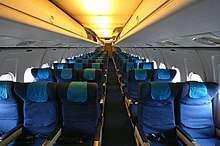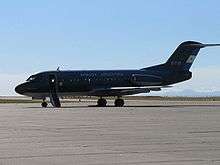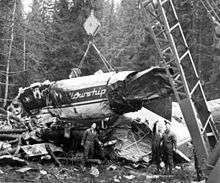Fokker F28 Fellowship
| F28 Fellowship | |
|---|---|
 | |
| A Piedmont F28-1000 on approach | |
| Role | Regional jet |
| National origin | Netherlands |
| Manufacturer | Fokker |
| First flight | 9 May 1967 |
| Introduction | 28 March 1969 with Braathens SAFE |
| Status | Very limited service |
| Primary user | Garuda Indonesia (historical) AirQuarius Aviation Gatari Air Service |
| Produced | 1967–1987 |
| Number built | 241 |
| Unit cost |
Mk 1000: US$2.9M, Mk 2000: US$3M (1970)[1] US$18-19M today |
| Developed into | Fairchild 228 Fokker 70 Fokker 100 |
The Fokker F28 Fellowship is a short range jet airliner designed and built by Dutch aircraft manufacturer Fokker.
Design and development

Announced by Fokker in April 1962, production was a collaboration between a number of European companies, namely Fokker, MBB of West Germany, Fokker-VFW (also of Germany), and Short Brothers of Northern Ireland. There was also government money invested in the project, with the Dutch government providing 50% of Fokker's stake and the West German government having 60% of the 35% German stake.
Projected at first to transport 50 passengers to 1,650 km (1,025 mi), the plane was later designed to have 60–65 seats. On the design sheet, the F28 was originally to mount Bristol Siddeley BS.75 turbofans, but the prototype flew with the lighter Rolls-Royce "Spey Junior", a simplified version of the Rolls-Royce Spey.
The F28 was similar in design to the British Aircraft Corporation BAC One-Eleven and Douglas DC-9, as it had a T-tail and engines mounted at the rear of the fuselage. The aircraft had wings with a slight crescent angle of sweep with ailerons at the tip, simple flaps, and five-section liftdumper only operated after landing to dump the lift. These were employed rather than reverse thrust as the designers felt that doing so not only reduced weight, but maintenance also. Having no reversers also meant that on unpaved airstrips there was less chance of the engines ingesting debris. The leading edge was fixed (although one experimental model had leading edge slats and these were offered as an option) and was anti-iced by bleed air from the engines. The tail cone could split and be hydraulically opened to the sides to act as a variable air brake – also used on the contemporaneous Blackburn Buccaneer. This design was also used on the HS-146, which became the BAe-146. The design is unique in that it not only slows the aircraft down rapidly, it can aid in rapid descents from economic cruising altitudes and also allowed the engines to be set at higher RPM which helped eliminate 'lag time'. This means the engines respond faster if needed for sudden speed increases or go-arounds on the approach to landing. The Fellowship had a retractable tricycle landing gear which used large low pressure tyres enabling the use of unpaved airstrips. Large wheel brakes also helped in shortening the landing run.
In terms of responsibility for production, Fokker designed and built the nose section, centre fuselage and inner wing; MBB/Fokker-VFW constructed the forward fuselage, rear fuselage and tail assembly; and Shorts designed and built the outer wings.
Final assembly of the Fokker F28 was at Schiphol Airport in the Netherlands.[2]
Operational history


The F28-1000 prototype, registered PH-JHG, first flew on 9 May 1967, flown by Chief Test Pilot Jas Moll, Test Pilot Abe van der Schraaf and Flight Engineer Cees Dik. German certification was achieved on 24 February 1969. The first order was from German airline LTU, but the first revenue-earning flight was by Braathens (who operated five F28s) on 28 March 1969.[2]
The F28 with an extended fuselage was named F28-2000 and could seat up to 79 passengers instead of the 65 seats on the F28-1000. The prototype for this model was a converted F28-1000 prototype, and first flew on 28 April 1971. The models F28-6000 and F28-5000 were modified F28-2000 and F28-1000 respectively, with slats, greater wingspan, and more powerful and quieter engines as the main features. The F28-6000 and F28-5000 were not a commercial success; only two F28-6000 and no F28-5000 were built. After being used by Fokker for a time, the F28-6000 were sold to Air Mauritanie, but not before they were converted to F28-2000s.[2]
The most successful F28 was the F28-4000, which debuted on 20 October 1976 with one of the world's largest Fokker operators, Linjeflyg. This version was powered by quieter Spey 555-15H engines, and had an increased seating capacity (up to 85 passengers), a larger wingspan with reinforced wings, a new cockpit and a new "wide-look" interior featuring enclosed overhead lockers and a less 'tubular' look. The F28-3000, the successor to the F28-1000, featured the same improvements as the F28-4000.
F28s of Ansett Transport Industries' Western Australian intrastate airline, MacRobertson Miller Airlines of Western Australia, flew the longest non-stop F28 route in the world, from Perth to Kununurra, in Western Australia – a distance of about 2,240 km (1,392 mi). This was also the world's longest twin-jet route at the time. MMA'a F28's also had the highest utilisation rates at the time, flying over 8 hours per day.
By the time production ended in 1987, 241 airframes had been built.[2]
Variants

_JP5830141.jpg)
.jpg)
- F.28 Mk 1000
- With a maximum capacity of 70 passengers, it was approved on 24 February 1969, the 1000C had a Main Deck Large Cargo Door.[3]
- F.28 Mk 2000
- Mark 1000 with a fuselage stretch of 57 in (1.4 m) in front of and 30 in (0.76 m) aft of the wing, 79 maximum passengers, approved on 30 August 1972.[3] Though it first flew on 28 April 1971 and successfully began revenue service with Nigeria Airways in October 1971, only ten were built.[2]
- F.28 Mk 4000
- Approved on 13 December 1976, it is built on the longer Mark 2000, with two overwing exits on both sides, a 60 in (1,500 mm) wing span extension, and capacity for 85 passengers.[3] The first prototype appeared on 20 October 1976 and it began service with Linjeflyg (Sweden) at the end of the year.[2]
- F.28 Mk 3000
- Mark 1000 with a 60 in (1.5 m) wing span extension, approved on 19 July 1978, with a 3000C variant with a large main deck cargo door.[3] A successful variant, featuring greater structural strength and increased fuel capacity, it began revenue service with Garuda Indonesia.[2]
- F.28 Mk 5000
- Was to combine the shorter fuselage of the Mk 3000 and an increased wingspan. Leading edge slats were to be added to the wings and more powerful Rolls-Royce RB183 Mk555-15H engines were to be used. Although expected to be an excellent plane to operate on short runways due to its superior power, the project was abandoned.[2]
- F.28 Mk 6000
- It first flew on 27 September 1973 and had the longer fuselage of the Mk 2000/4000 with an increased wingspan and leading edge slats. It was certified in the Netherlands on 30 October 1975. Two were built by 1976.[2][4]
- F.28 Mk 6600
- Proposed version. Not built.[2]
- Fairchild 228
- Proposed 50 seat American version to be assembled by Fairchild-Hiller with Rolls-Royce RB.203 Trent engines.[5] Project cancelled.
Operators
In August 2006 a total of 92 Fokker F28 aircraft remained in airline service. Major operators included: MacRobertson Miller Airlines, Ansett Group Australia (more than 15), Toumaï Air Tchad (1), AirQuarius Aviation (3), SkyLink Arabia (1), Satena (1), Gatari Air Service (2), LADE (1), AirQuarius Aviation (4) and Merpati Nusantara Airlines (1). Biman Bangladesh Airlines (2). Some 22 airlines operated smaller numbers of the type.[6] As of July 2018, Fly-SAX is the only airline operator of the F28 worldwide with 1 aircraft in service.[7]
Military operators
.jpg)

- Algerian Air Force (2) delivered in 1979 [8]
- Ghana Air Force (1)
- Philippine Air Force (1 – Used for domestic presidential Flights, The aircraft was named "Kalayaan")

Accidents and incidents

The following is a list of Fokker F28 accidents and incidents:
- Braathens SAFE Flight 239 – 23 December 1972, (Asker, suburb of Oslo, Norway): 40 fatalities. First fatal crash of a Fokker Fellowship.
- Itavia – 1 January 1974, (Caselle Torinese, airport of Turin, Italy): 38 fatalities. Flight IH897 from Cagliari to Geneva with intermediate stops in Bologna and Turin, crashed about 2 miles south of Runway 36 while attempting to land in fog. Airplane involved was registered I-TIDE.
- Turkish Airlines – 26 January 1974, (Izmir, Turkey): 66 fatalities. the aircraft crashed down 100 m (330 ft) away from the airfield during takeoff.
- Garuda Indonesia Airways Flight 150- 24 September 1975 near Palembang, Indonesia ): 26 fatalities. Crashed on approach in fog killing 25 people out of 61 passengers and crew. 1 person was killed on the ground.
- Garuda Indonesia Airways- 11 July 1979. 61 fatalities. Crashed into Mount Sibayak while on approach to Polonia International Airport. There was bad weather at the time of the crash.
- NLM CityHopper Flight 431 – 6 October 1981 (Moerdijk, North Brabant, Netherlands): 17 fatalities, the aircraft flew into a tornado which broke off one of the wings.
- Garuda Indonesia Domestic Flight – 20 March 1982, runway overrun at Tanjung Karang-Branti Airport in bad weather, 27 fatalities.
- Air Ontario Flight 1363 – 10 March 1989 (Dryden, Ontario, Canada): 24 fatalities. Due to various factors including snow, ice and lack of use of anti-icing measures.
- USAir Flight 405 – 22 March 1992 (Queens, New York, United States): 27 fatalities. Due to ice buildup on the wings, pilot error and improper deicing procedures at LaGuardia airport
- Merpati Nusantara Airlines Flight 724 – Fokker F-28 Mk-3000 Registered GK-GFU - 1 June 1993. Domestic Flight (Sorong, Papua, Indonesia): 41 fatalities. Controlled flight Into terrain - The aircraft crashed onto a rocky beach. On Bad Weather Landing procedures at Jefman Airport[10]
- Iran Aseman Airlines Flight 746 – 12 October 1994 ( near Natanz, Iran ): 66 fatalities.
- Air Mauritanie Flight 625 – 1 July 1994: All 4 crew and 76 of the 89 passengers on board were killed when their plane crashed at Tidjikja Airport.
- TANS Peru Flight 222 – 9 January 2003: None of the 46 passengers aboard the Fokker F-28 survived after the aircraft hit a mountain near Chachapoyas, Peru.
Aircraft on display
- 11009 - F28-1000 registered LN-SUC at the Norwegian Aviation Museum, Bodø, Norway in Braathens SAFE livery.[11]
- 11016 - F28-1000 registered N500WN at Wayne Newton's Casa de Shenandoah, Las Vegas, Nevada.[12]
- 11161 - F28-4000 registered XY-AGH at the Defense Services Museum, Naypyidaw, Myanmar in Myanma Airways livery.[13]
- 11175 - F28-4000 registered PK-MGJ preserved as a movie theater in Baturraden, Central Java, Indonesia.[14]
Specifications
| Variant | -1000[15] | -2000[15] | -4000[16] | -3000[16] |
|---|---|---|---|---|
| seating[lower-alpha 1] | 65 | 79 | 85 | 65 |
| Hold | 459 cu.ft / 13m³ | 559 cu.ft / 15.9m³ | 459 cu.ft / 13 m³ | |
| Length | 89ft 10in /27.4m | 97ft 2in / 29.6m | 89ft 10.7in / 27.4m | |
| Height | 27ft 9.5in / 8.47m | |||
| Wingspan | 77ft 4in / 23.6m | 82ft 3in / 25.07m | ||
| Wing | 822ft² / 76.4m², 16° sweep, 7.3:1 AR | 850ft² / 79m², 16° sweep, 8:1 AR | ||
| Max takeoff weight | 65,000lb / 29,480 kg | 73,000lb / 33,110 kg | ||
| Empty weight | 35,517lb / 16,144kg | 36,953 / 16,707kg | 38,825lb / 17,611 kg | 37,139lb / 16,846kg |
| Max payload | 18,983 / 8,629kg | 17,547 / 7,976kg | 23,317lb / 10,556kg | 19,003lb / 8,620kg |
| Max Fuel | 2,869 Imp Gal / 13,040 l | |||
| 2× Turbofans | Rolls-Royce Spey Mk 555-15 | RB.183 Mk 555-15H | ||
| Unit thrust | 9,850lbf / 43.9kN | |||
| Cruise | 458kn / 848km/h Max, 359kn / 666 km/h LR | 436kn / 808km/h Max, 354kn / 656 km/h LR | ||
| Fuel Consumption | 6,180lb/h / 2,800kg/h Max, 3,260lb/h / 1,480kg/h LR | 4,980lb/h / 2,260kg/h Max, 3,252lb/h / 1,475kg/h LR | ||
| Max PL Range | 920nmi / 1,705km | 900nmi / 1,668km | 1,550nmi / 2,872 km | |
| Takeoff (MTOW, ISA, SL) | 5,500ft / 1,676m | |||
| Landing (MLW, SL) | 3,540ft / 1,079m | 3,495ft /1,065m | 3,173ft / 967m | |
| Service ceiling | 35,000 ft (10,700 m)[3] | |||
- ↑ 5-abreast, 31in / 79cm pitch
See also
Related development
Aircraft of comparable role, configuration and era
Related lists
References
- ↑ "Fokker F.28 Series 2000". Flight International. 21 May 1970.
- 1 2 3 4 5 6 7 8 9 10 Antonio López Ortega (1999). Reactores Comerciales [Commercial Jetliners] (in Spanish). Agualarga Editores S.l. ISBN 978-84-95088-87-1.
- 1 2 3 4 5 "Type Certificate Data Sheet No. A.037 for Fokker F28" (PDF). EASA. 3 September 2018.
- ↑ Taylor 1976, p. 137
- ↑ "What happened to the Fairchild 228?". AAHS Journal. Spring 1998.
- ↑ Flight International, 3–9 October 2006
- ↑ "World Airline Census 2018". Flightglobal.com. Retrieved 2018-08-26.
- ↑ "Trade Registers".
- ↑ Air International May 1988, p. 233.
- ↑ Ranter, Harro. "ASN Aircraft accident Fokker F-28 Fellowship 3000 PK-GFU Sorong-Jefman Airport (SOQ)".
- ↑ "Fokker F 28 1000 Fellowship". Norwegian Aviation Museum. Retrieved 9 July 2018.
- ↑ "11 Unusual Preserved Airliners in the USA". Airport Spotting. Retrieved 9 July 2018.
- ↑ "Fokker F-28-4000, XY-AGH / 1114". ABPic. Retrieved 9 July 2018.
- ↑ "REGISTRATION DETAILS FOR PK-MGJ". Planelogger. Retrieved 9 July 2018.
- 1 2 "Commercial aircraft survey". Flight International. 24 October 1974.
- 1 2 "Commuter airliner guide". Flight International. 21 March 1981.
- "Andean Air Power...The Peruvian Air Force". Air International. Vol. 34 no. 5. May 1988. pp. 224–235, 240.
- Taylor, John W. R., ed. (1976). Jane's All the World's Aircraft 1976–77. London: Jane's Yearbooks. ISBN 978-0-354-00538-8.
Further reading
| Wikimedia Commons has media related to Fokker F28 Fellowship. |
- "Slatted F.28". Flight International. 7 December 1972.
- "F.28 update". Flight International. 1 May 1975.